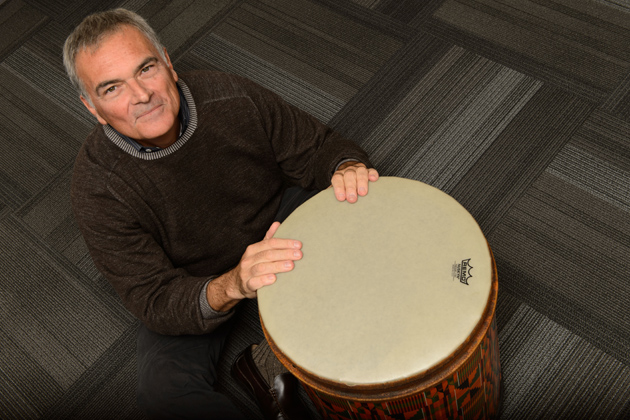
Ed Large has managed to combine his interests in music, mathematics, and the mysteries of neural networks into a career as a theoretical neuroscientist. Large, who joined the Department of Psychology’s expanding cognitive science group in the fall, comes to Storrs from Florida Atlantic University as part of UConn’s faculty hiring initiative.
In one sense, Large has come home. He is a native of West Hartford, where he first developed an appreciation for music (with designs on becoming a professional musician) and math. But it was not family or fond memories of New England’s changing seasons that inspired his return to the state.
“I think what’s going on here at UConn is really special,” he says, “and this [psychology] department seems to be the perfect home for the kind of research I do. I know of other departments around the country that have excellent people, and a few of them may even be hiring, but I couldn’t help but be impressed with the University’s vision for the future and its commitment to both the STEM fields and to the humanities.”
Large, who earned his Ph.D. from The Ohio State University and subsequently did postdoctoral work at the University of Pennsylvania, has long been captivated by what he refers to as ‘the fundamental mystery’ of music.
Music, he says, is a form of communication that relies on highly structured temporal sequences comparable in complexity to language. Unlike language, however, music does not refer to an external world. Rather, it consists of self-contained patterns of sound, and certain aspects of these patterns are universally found among musical cultures.
“How does music evoke emotional experiences?” he asks. “How does it make sense? What‘s the difference between a random sequence of notes and a melody?”
These are the questions that led to his interest in nonlinear dynamical systems, auditory neuroscience, and music psychology. Large uses theoretical modeling in conjunction with behavioral, neurophysiological, and neuroimaging techniques to understand how people respond to complex, temporally structured sequences in both music and speech.
He and his colleagues have pioneered the idea that attention is a dynamic and inherently rhythmic process. Current research projects include rhythm perception, cortical dynamics of attention, pitch perception, perception of musical tonality, auditory brainstem neurodynamics, auditory pattern recognition and plasticity, and emotional communication in music.
Rhythms in the brain
“One of the things I’m convinced of,” he says, “is that the concept of the brain as a computer isn’t really accurate. My research indicates that the brain does what it does, in part, due to neural oscillations … different parts of the brain produce rhythms at different frequencies at different phases. These synchronize with one another and somehow that’s what produces our conscious awareness, our thoughts, our emotions … everything. What I’m talking about, literally, is the activation of populations of neurons waxing and waning over time.”
Large explains it this way, “Delta rhythms in the brain, with frequencies between 1 and 4 cycles per second, correspond to the basic beat of most music. The theta band, between 4 and 8 cycles per second, corresponds to the repetition rate of syllables in spoken language. Motor responses utilize the beta band between 13 and 30 cycles per second, while cognitive processes occupy the gamma band with frequencies between 10 and 100 cycles per second. These four brain rhythms nest within one another, and the brain is able to synchronize them with rhythms in the external world.”
Recently, Large has been studying tonality and pitch. “It might surprise you to learn that the fundamental neural mechanisms that underlie our perception of pitch are still not well understood,” he says. “My colleagues and I think that the same kinds of mechanisms that underlie our perception of rhythm might also underlie the perception of pitch. It just happens on a faster time scale.”
In addition to his teaching and research, Large has two books forthcoming, Signal Processing, Pattern Formation, and Plasticity in Networks of Neural Oscillators and Music Neurodynamics, both targeted for publication in 2015. On Jan. 1, he began serving a two-year term as president of the Society for Music Perception and Cognition, an international organization devoted to the scientific and scholarly understanding of music from a broad range of disciplines.
The beat goes on
When he welcomes students to his new lab in the renovated Arjona building, the facilities will include soundproof booths, an EEG lab, a listening lab, and a music recording lab containing a computer-monitored piano and other instruments.
“We use a number of different techniques for measuring perception and behavior,” Large says, “and that includes everything from the use of electroencephalography (EEG) to recording electrical activity via electrodes placed on the surface of the scalp, to simply asking people to tap in synchrony with a rhythm. The research is interesting and challenging, and it also leaves room for the ‘inner musician’ in all of us.”




